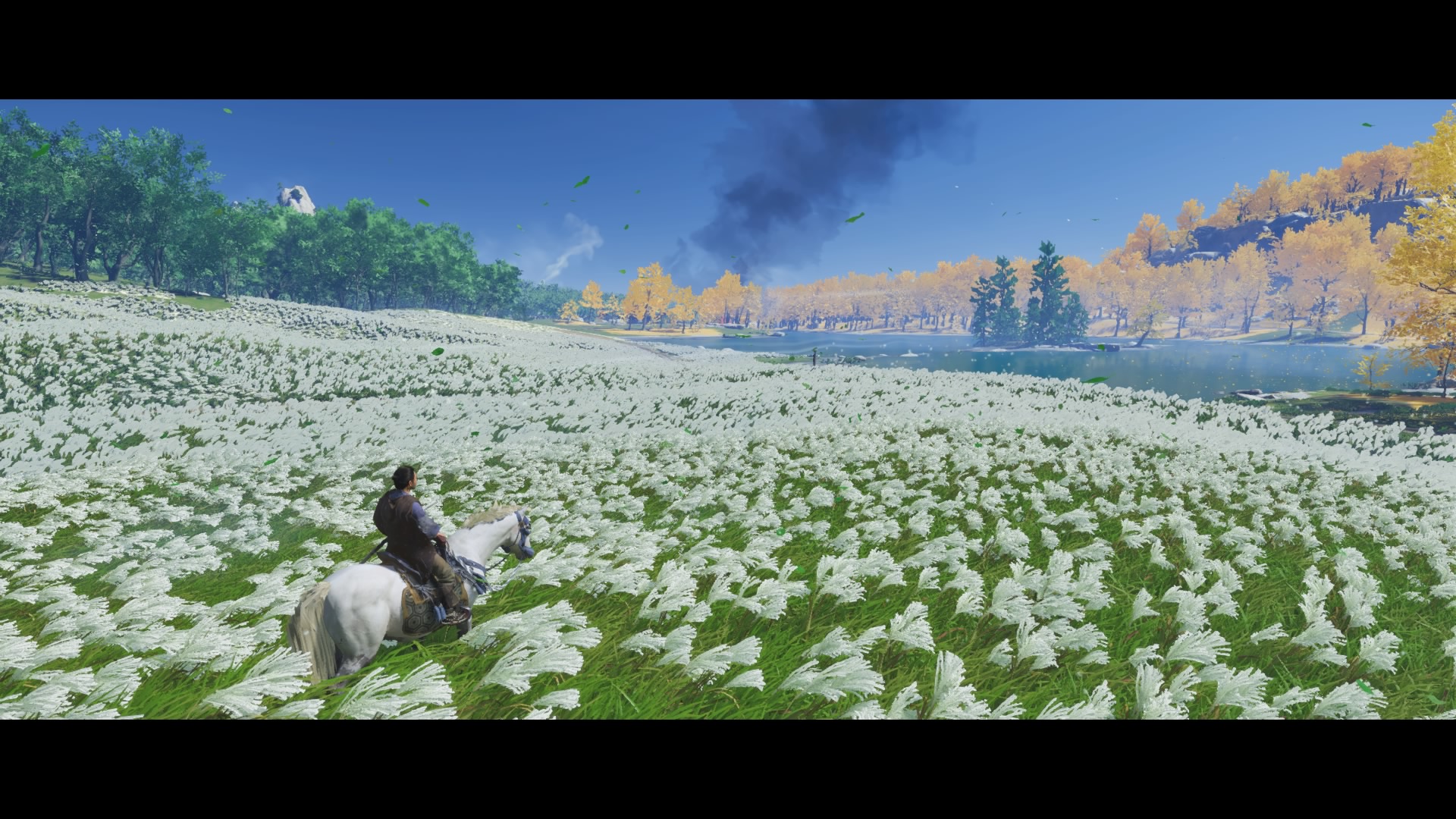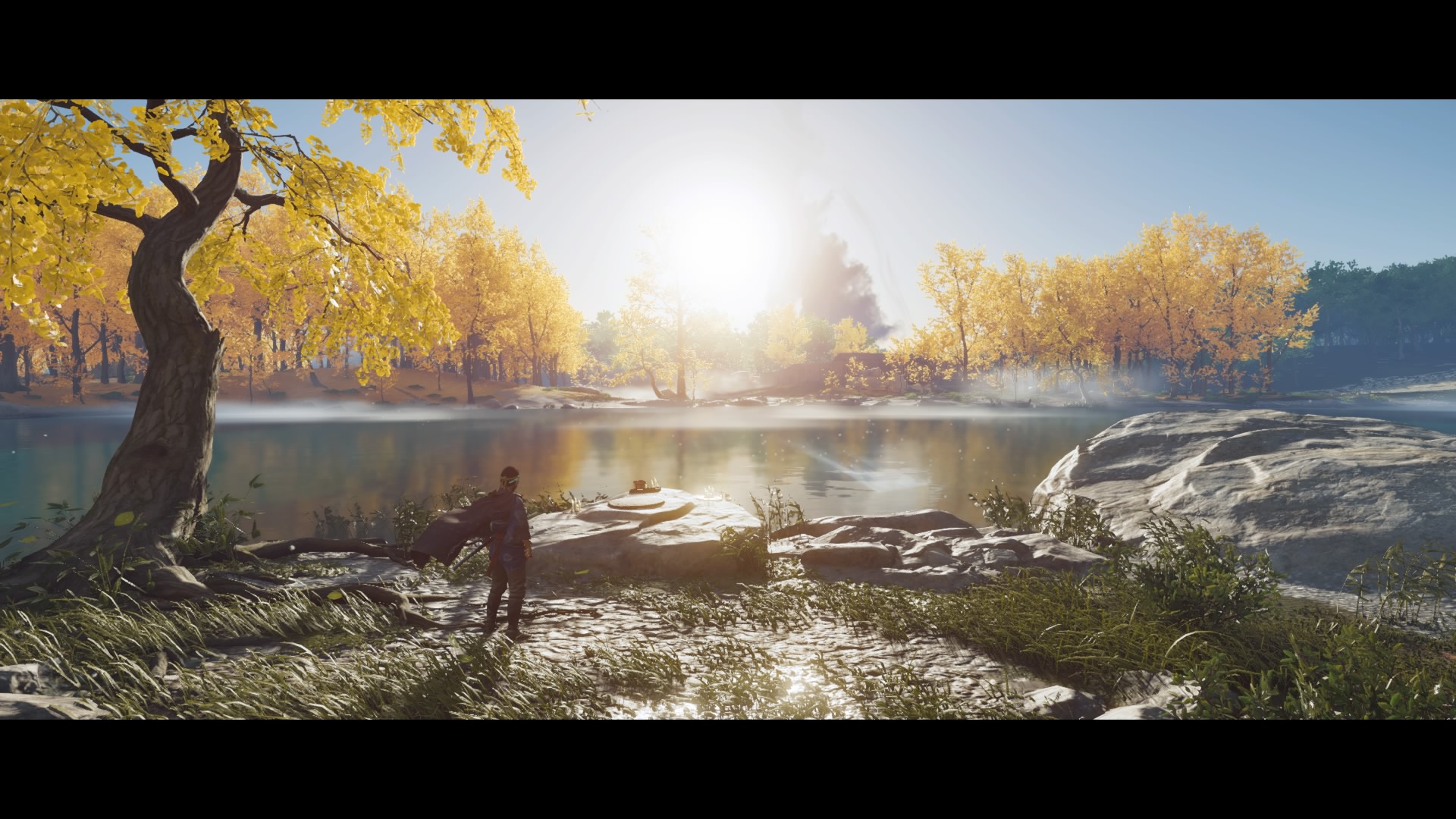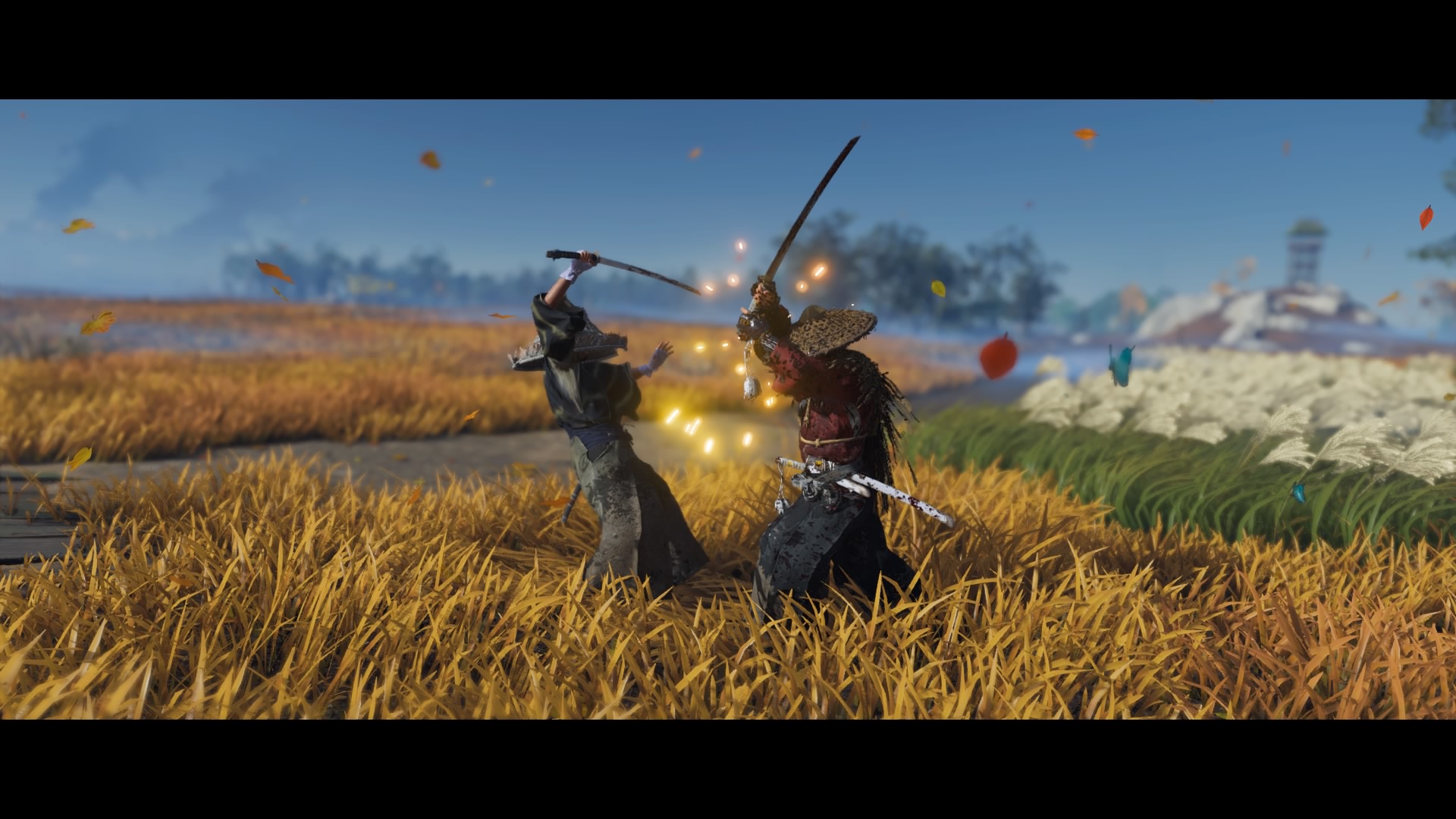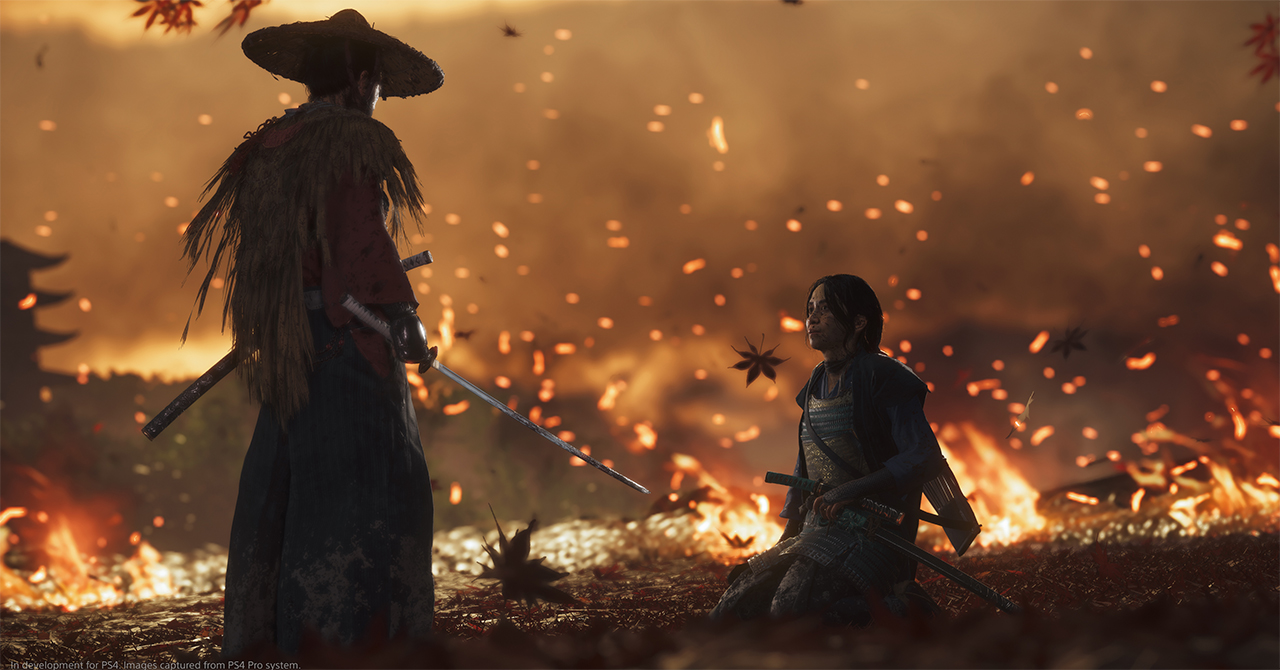Ghost of Tsushima is a beautifully realized, if stylized, version of 13th century Japan, and it many of its fantastic environments make you feel and act like a samurai badass. Rather than go for the all-encompassing scope of a true open-world epic, this game narrows its focus on only what it feels matters.
ThoughTsushima somewhat falters in the character story it tries to tell, aiming for familiar tropes and predictable plotlines, and the writing consistently falls below the standards of the best sandbox games, its world itself, combat, and moment to moment flow it above those shortcomings.
Note: This review contains mild story spoilers.
Ghost of Tsushima Review: A Blade in the Shadows
This version of the island of Tsushima might not be a one-to-one recreation of its real-world inspiration, but it doesn’t need to be. The designers at Sucker Punch instead focused on cinematic quality, where natural colors and environments paint a particular picture and tell a certain story.
In that, they succeeded.
Just moving about the landscape in Ghost of Tsushima is a treat, from the excellent use of color to the way the wind plays with the grasses and trees. While I think there are prettier sunsets in more fantastical games, the ones here are no doubt some of the warmest and most comforting I’ve seen.
Every location in the game uses a limited palette of colors but does so with purpose and conviction. You don’t have to spend much time in the Golden Temple, for instance, to know why it earned the name.
Amazing Audio/Visual Design
Tsushima‘s sound is on point as well. Drawing and sheathing your sword, slicing through enemies, crunching dried leaves beneath your feet — it’s all here. Music is also well-used. While a little dramatic at times, soaring crescendos and subdued tones prove that the designers favored subtlety over ostentatiousness whenever possible.
The wind, one of the game’s primary themes and a crucial navigational mechanic, is the real winner here. It’s subtle when it needs to be, whistling only enough to add atmosphere and weight to a dramatic scene or wafting softly when taking down the energy during a serene one. And there’s nothing that makes a samurai/ninja hybrid look more badass than a cape flowing in the wind as he stands over his defeated and demoralized enemies.
In short, the audio and visual design on display in Tsushima is top-notch. There are several minor graphical issues to contend with, unfortunately, including hit-or-miss cloth and water simulation or funky facial construction and animation. Thankfully, these complaints are offset by the sense of wonder experienced between set pieces. No matter what just happened in combat or the story, you can and should return to exploring the island for the sake of it.
There are a lot of little touches that add to the cinematic flair, too. Riding through a field of flowers sees Jin Sakai, the game’s main character, reach down to feel the petals on his skin. Slow walking through the same flowers will see him open his palms to the sky for the same reason.
Taken together, the aesthetic, sound, and world-design create an experience that looks as close as we’ve ever come to playing a modern, albeit somewhat Westernized, samurai film.
Visceral Combat, Muted Writing
Ghost of Tsushima does not have the depth of systems found in a game like Red Dead Redemption 2 or The Witcher 3, nor does it offer the freedom of play found in Breath of the Wild. Its closest analog might be Horizon: Zero Dawn, in the sense that the gameplay of the two centers on just a few primary mechanics, which they sharpen to a razor’s edge.
To that end, the other star of Ghost of Tsushima is undoubtedly its combat. It’s visceral, satisfying to execute, weighty when it needs to be, and always fast. It’s divided mechanically between two disparate styles: Samurai and Ghost. Or, put in different terms, action and stealth.
That’s how it seems at first, at least. In truth, the real joy of fighting in Ghost of Tsushima is how seamlessly you can transition between Samurai and Ghost styles.
The stealth mechanics themselves are standardized, but many of the skills you gain to that end have more active components to them. For example, you can certainly take out a guard with a few well-timed kunai, but you can also start a head-on assault with a flurry of them for a completely different effect.
Your sword abilities are more active, but that doesn’t stop them from coming in handy if that one guard just happens to see you at the wrong time. Taking fights head-on has plenty of charm, too, as the interplay between offense and defense is incredibly enjoyable, even in groups.
You can and will become a whirling dancer of death if you take the time to unlock and master the various combat mechanics and skills. By the game’s end, most enemies are child’s play, and the only ones to give you a challenge might be the various duel fights scattered throughout the story.
Sadly, there’s not a ton of enemy variety here to test your skills against. It boils down to about five different versions of “guy with bow/sword/spear.” There are a few hostile animals, but not enough to speak about.
There aren’t any non-human bosses either, though, as mentioned, the duels you fight against them are some of the most satisfying encounters, as it’s just your skill against theirs. You can certainly learn the tells to their attacks, bait specific patterns, and exploit the AI quirks you find, but from a narrative perspective, they are some of the strongest moments on offer.
A Story in Need of Better Writing
It’s too bad the story itself is predictable, trope-filled, and somewhat dull. Based only on what you know of the game from its marketing, you can safely assume most of the plot without too much trouble.
The story goes to great lengths to show how the “way of the samurai” and the “way of what is necessary” diverge, and how that conflict shapes Jin and his relationship to the wider world.
A series of flashbacks early in the story underscores how the young samurai had been raised. Honor was paramount, and everyone was to be treated with the respect they deserve. You face your enemies and look them in the eyes, even as you slay them. Fear and trickery were unacceptable.
The Mongols changed all that. Jin sees a foe that cannot be defeated using conventional means, and so adapts the only style of warfare he sees is effective: silence and subterfuge.
As he slaughters his way through the Mongol horde, he loses more and more of himself to this dishonorable style of fighting, and by reading that, you should know where most of the interpersonal conflict occurs. If you know anything about storytelling, you should also be able to pull out when it’s going to happen, what the different parties will say, and what the outcome will be.
If a character in a story is defined by their ability to change, I’m sad to report only Jin does so in any significant capacity. Granted, we spend a great deal more time with him than anyone else, murdering our way across Tsushima. Still, almost no other character looks at the situations they find themselves in and reevaluates their worldview.
Flashes of Potential
The only character other than Jin who reflects on their actions in any measurable way is Masako Adachi, but for the majority of your time with her, she is of one mind, focused purely on revenge. It’s only at the end of her questline that she looks back on what she’s done and what she will do and tries to take stock.
Certainly, the main villain is about as stock as they come. Though he has some of the traits of the historical Mongols when it comes to tactics, he is too arrogant and sure of his victory long before it’s been won.
He’s also somewhat prone to monologuing when the practical option would be so much more effective. He doesn’t quite come off as mustache-twirling, as he’s a little too pragmatic for that, but some of the things he does remind me more of a comic book villain than anything else.
For all the faults in its storytelling and characters, there’s still a lot to like about Ghost of Tsushima. There are lots of little details that bring the world to life, and its sidequests are some of the best storytelling moments in the game.
Fashion is a big seller, too, as you can outfit Jin in any number of different armors, masks, and hats to make him look as cool as you like. There are different sheathes for your katana, colors for your clothes, and obnoxious hats to make yourself look silly while you cut down three enemies in as many strokes.
While it might not make sense logically, the ability to change clothes mid-fight is beneficial, as the various armors come with useful skills unique to them. Changing from a Ghost-focused armor to a samurai focused one will save your life in the later fights, but there’s nothing stopping you from wearing only what you think looks cool.
There are plenty of other collectibles out in the world, as well. From Mongol artifacts that come with lore entries, to flags that you turn in for new horse saddles, and much more. A lot has been said about the various haiku the game helps you write, and while they’re all mostly trash as both poems and haiku, they’re functional trash. They pluck the heartstrings and use some pretty language, which is all I want or expect out of my video game poetry.
Ghost of Tsushima Review — The Bottom Line
Pros
- Amazing world and beautiful environments
- Visceral, satisfying combat
- Excellent sound design and music
Cons
- The writing is often average at best
- Animation and graphics sometimes need work
Ghost of Tsushima does a lot of things right. Its got fun combat, a wonderfully designed world, and top-notch sound design. Neither the story nor the characters moved me in any real way, even though I could tell both were trying.
The game isn’t the technical or mechanical achievement of this year or even the last five, but neither was it trying to be. This here is a fun game to sink 20 or 30 hours into and come out satisfied. And that’s a worthy goal for any video game, even one with higher aspirations.
[Note: The reviewer purchased the copy of Ghost of Tsushima used in this review.]













Published: Jul 27, 2020 06:55 pm